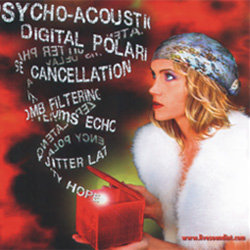
MORE CONCRETE
There are two main effects of latency: echo and phase cancellation, the latter also referred to as comb filtering.
Echo seems to be somewhat of a matter of conjecture regarding how much latency a performer can experience with in-ear monitors before it becomes a noticeable.
Time for something more concrete, so some Whirlwind engineers and I decided to do a few experiments of our own.
The Haas Effect (or Precedence Effect) is a principle first set forth in 1949 by Helmut Haas which established that we humans localize sounds by identifying the difference in arrival time between our two ears.
The same sound arriving within 25 ms to 35 ms of itself will be suppressed and not be heard as an echo.
Only if sounds are more than about 35 ms apart will the brain recognize them as separate sounds or echoes. We tested this, connecting a microphone through a 20 ms delay and monitored with Shure E2 ear buds.
The principle here: when you monitor your own voice, the delayed sound mixes in the ear with non-delayed sound that is conducted through your head via bones, cartilage and Eustachian tubes. This effect should be exaggerated when using headphones or in-ear monitors, because the listener is not hearing all of the other room reflections with various delays and volumes.
Several people were asked to read aloud from a magazine. The subjects included experienced sound professionals and musicians, amateur players and non-technical people with no monitoring experience. Everyone heard the initial 20 ms delay as a very short echo or “doubled” sound.
Then, the delay was gradually reduced from 20 ms. The subjects were told to stop us when the delay seemed to disappear. Then this was repeated while the person spoke short, sharp syllables like “check, check!”
Every person tested seemed to think the echo disappeared somewhere between 10 ms to 15 ms. I personally found it to be a rather dramatic change too – as if someone had suddenly bypassed the delay unit.
Next, we wanted to evaluate the situation where a guitarist is playing direct to the PA, or a drummer is using electronic drums.
I played guitar into the delay and monitored through headphones while only listening to the delay.
At long delays, playing in time is impossible. You have to “wait” to hear the note, and your playing gets slooowwwer and sloooowwwwwer.
It’s a weird feeling, almost made me feel like I was going to fall over. Now I know what singers go through when they’re trying to sing the national anthem in a stadium where the echo comes back at them with a long delay!
